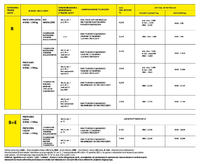LIST OF AUTHORIZATIONS AND CONDITIONS RELATING TO TOWING A TRAILER BY A PASSENGER CAR WITH A TOTAL WEIGHT OF UP TO 3,500 kg. 
The column of the table "OPTIMAL EXAMPLES" are calculated in terms of achieving the highest GVW of the trailer. This makes it easier to evaluate, but in practice it will be rather difficult to achieve such a parameter...
Of course, further, other restrictions apply. The permissible total weight of the trailer towed by the passenger car must not exceed the maximum towable weight specified for it
vehicle by the manufacturer, the value of which is entered in the registration certificate. Also the coupling devices mounted on the car must have a homologated load value. In a whole series of successive dependencies and constraints
the so-called "bottleneck principle" - that is, we have the largest towed weight limit.
Since the preparation of the table requires the use of many provisions scattered over several Acts and Regulations, the table may need to be supplemented with additional elements. I am counting on the constructive help of colleagues here...
The main legal acts taken into account during the preparation of the table are:
- Act on Drivers of Vehicles
- The Road Traffic Act
- Ordinance of the Minister of Transport on the rules of the exam for driving license category B
- Regulation of the Minister of Infrastructure on the technical conditions of vehicles and the scope of their necessary equipment.
With regard to the old regulations before the amendment, the main change consists in the possibility of towing a heavy trailer with a category B driving license with a GVW of more than 3,500 kg, but not more than 4,250 kg. In this case, a B+E driving license is not required, but you must pass the exampractical (inscribed in the driving license as
category B96) .
Also, the existing regulations on vehicle drivers allowed to tow a combination with a light trailer with a total GVW of 3,500 kg. The fact that such a set could be towed with a total GVM of 4,250 kg resulted from the provisions of the Vienna Convention, to which Poland joined. There was an obvious contradiction and ... constant discussions with the police on the road what can be done. The current provision of the Act clearly increases the GVW of such a set to 4,250 kg.
The requirement that with a category B driving license, the GVW of the trailer cannot be greater than the curb weight of the towing vehicle has disappeared.
===============
The general conclusion is that the regulations are already so complicated that perhaps doctoral studies are not needed yet, but a cheat sheet and a calculator are for sure. So I am not surprised that policemen on the road get lost in this and do not know how and what to control and check.
In addition - to make it even more difficult - there are other restrictions for trucks and off-road vehicles.
There are other requirements, e.g. paragraph 3, p.7 of the technical requirements says: "A combination of vehicles consisting of a passenger car and a trailer, loaded to
values of the maximum weights, should move at least 5 times in 5 minutes up a hill with a slope of 12%." Hm ... I wonder how the person who invented this regulation imagines its enforcement?



